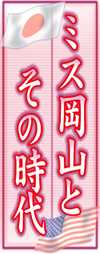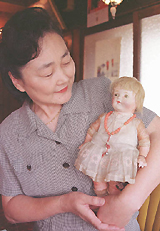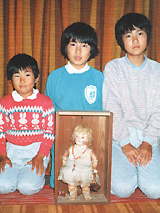Emiko Yagi (52), a resident of Kamo Town in Okayama Prefecture, considers herself to have four daughters, the oldest girl, the middle one, the youngest one, and "Roycegood Weil," an American doll. Roycegood Weil is one of the Friendship Dolls given by America in 1927 to elementary schools and kindergartens throughout Japan. It is known from the details written on an existing wooden box from those days that Kamo Elementary School received the doll. When neighboring towns were merged together, Kamo Elementary School was moved and consolidated several times. Many dolls nationwide disappeared in the midst of such confusion. In about 1955, because the school building used until that time was to be abandoned and the school divided into three schools, Emiko's grandmother Tsuya (died in 1974), who worked as a midwife and who was Kamo Town's first town councilwoman, took the doll home to take care of it.
The doll has jade-green eyes with blond hair. There are embroidered pink flowers on her fine white dress, and she wears delicate handmade underwear and carries a flower basket. She also has socks and a coral-colored necklace. "She's so pretty, I adore her, I adore her. When friends come, I slip her out of the box in this way." Emiko lightly strokes Roycegood Weil's hair as she holds the doll in her arms. "You're really cute."
In February 1980, when Emiko read an article on Friendship Dolls published in the Sanyo Shimbun, she learned that Roycegood Weil is one of the few "Friendship Dolls" still in existence. She tried to return the doll to the reintegrated Kamo Elementary School as "evidence of children's friendship." However, she was asked "to keep the doll as is rather than have it kept at the school where teachers and staff often change." Since then, she has tried to lend the doll for exhibitions so that many people may see her. There were also sad events. About ten years ago, when Roycegood Weil returned from an exhibition, some of her hair had fallen out, and the paint on her skin had cracked and chipped off. The damage was probably caused by fumigation to kill insects. Thinking of her younger sister growing up together, we took loving care of the doll like a daughter. It was hard for me, but she was not repaired. "If she were fixed up, I would feel like she had become another person." Emiko's youngest daughter Masae, who is a senior in college, says, "The doll is my mother's treasure. I am proud both for there being an historical item in my home and for my mother preserving the doll by really taking good care it." (published September 30, 2001) |



